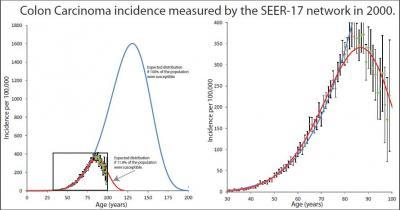Cancer, it is said, is nature's way of telling us to 'get the hint'. At a certain age, we all have more friends who get cancer. The older we get, the more often it happens. Even if we somehow slow aging, we would end up with cancer eventually, just like Gilles-Eric Séralini's experimental rats were predestined to get cancer when he let them live long enough.
Cancer is inevitable.
Perhaps not all cancer. The risk of developing several common cancers decreases with age, which has been a mystery. Mystery or not, it is what it is and researchers want to be able to take advantage of what they know.
Cancer research has three general focal points: how can we diagnose tumors earlier, how can we treat cancer patients to prolong and enhance their lives, and how do tumors originate. Insight into how cancers originate may ultimately lead to an understanding of how to reduce the number of cancer patients.

The age-specific incidence of colon carcinoma, as measured by the SEER-17 network of cancer registries in 2000, is plotted along with the best fit Weibull distribution for 100% of the population and for 11.8% of the population on the left. Both distributions were fit to data from ages 0 to 85 years of age, and then data from 86󈟏 years of age were plotted. The data is clearly consistent with the 11.8% curve, but not the 100% curve. The plot on the right is a detail of the outlined section of the plot on the left. Credit: Professor James P. Brody of the Department of Biomedical Engineering at the University of California, Irvine
Writing in Biophysical Reviews and Letters, Professor James P. Brody of the Department of Biomedical Engineering at the University of California, Irvine, postulates that many cancers originate early in life, possibly before birth. This is called the developmental origin of disease hypothesis. If true, this suggests that a test could be developed that would determine whether a person might develop a specific form of cancer decades before they actually develop it.
"Most cancers have a characteristic age at which they occur. Testicular cancers mostly occur from age 25-40, bone sarcomas in the teens. Beyond the characteristic age, the incidence of these cancers decreases. Several common cancers appear to have a characteristic age greater than the typical lifespan. Observations of these cancers have led to the belief that the incidence of these cancer increases without limit," Brody says.
"However I believe that we just don't see the decrease of the incidence for some common forms of cancer because people don't live long enough to see it."
Such a test would lead to earlier diagnosis and preventing many forms of cancer from ever developing to the life threatening stage.





Comments